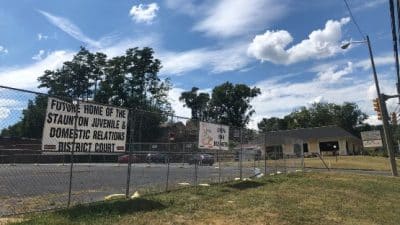
High school students at the technology center, which serves both Giles and Narrows high schools, are creating a house for Habitat for Humanity in their shop. They have a good grasp of traditional building methods but aren’t familiar with green building practices.
School officials and representatives from Habitat for Humanity met with Daniel Hindman, associate professor of wood engineering in Virginia Tech’s College of Natural Resources and Environment, to discuss how to incorporate green building practices into the house.
Hindman, who researches efficient uses of wood, volunteered to have students in his Green Building Systems course provide lessons for the high school students.
The concept so impressed Technology Center Principal Forest Fowler that he asked Hindman to present the idea to a group of technical educators and administrators from Floyd, Giles, Montgomery, and Pulaski county schools as well as New River Community College.
The Virginia Tech students, all juniors and seniors, were tasked with creating models, posters, and interactive displays to demonstrate green building concepts. Working in teams of three or four, they addressed the topics of energy use, disaster protection, the definition of green building, material life cycle planning, passive house concepts, and construction details of floors, roofs, and walls.
“I realized this was a great project to get my students involved in,” Hindman said. “They demonstrated what they had learned over the course of the semester by creating teaching modules on aspects of green building to educate the high school students. They’re energized by this project because of its service learning component.”
More than 30 students and teachers from the Giles County Technology Center and Christiansburg High School came to the Blacksburg campus last month. They first visited LumenHAUS, Virginia Tech’s award-winning 600-square-foot solar home, and then headed to Bishop-Favrao Hall, where Hindman’s students gave presentations and demonstrated the models they created.
Hindman, a faculty member in the Department of Sustainable Biomaterials, pointed out that trees are a renewable resource — a fundamental reason for wood qualifying as a green building material.
“The visitors learned how the concepts of sustainability and making efficient decisions are the future of the building construction industry,” Hindman said.
They also heard about how homes can be designed with the resiliency to withstand high winds, earthquakes, and other stressors, and can be modified as residents age.
The College of Natural Resources and Environment at Virginia Tech, which consistently ranks among the top three programs of its kind in the nation, advances the science of sustainability. Programs prepare the future generation of leaders to address the complex natural resources issues facing the planet. World-class faculty lead transformational research that complements the student learning experience and impacts citizens and communities across the globe on sustainability issues, especially as they pertain to water, climate, fisheries, wildlife, forestry, sustainable biomaterials, ecosystems, and geography. Virginia Tech, the most comprehensive university in Virginia, is dedicated to quality, innovation, and results to the commonwealth, the nation, and the world.










